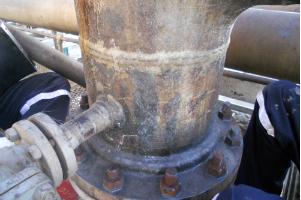 Removing corrosion in pipes and leaks is a time- and money-consuming process. Therefore, there is the option of repairing the equipment during its operation with epoxy-based products.
Removing corrosion in pipes and leaks is a time- and money-consuming process. Therefore, there is the option of repairing the equipment during its operation with epoxy-based products.
by Pedro Sánchez*
New heat-activated epoxy products are being used to repair leaks and corroded pipes that work at high temperatures, in situations where it is impossible to stop the equipment to carry out the repair. It is therefore advisable to have a product that repairs in situ those systems in which stopping the equipment represents a high cost.
However, it is common to find many systems composed of pipes, tanks or containers that have not been designed to perform service cuts. Additionally, these systems over time degrade more each year. For this reason, emergency repair materials are required as a tailor-made solution for this particular type of problem.
This is how, for decades, different types of industries around the world have made a great effort to keep working the systems of pipes damaged, because of the environment.
Scientists have designed materials to make these repairs efficiently. In addition to providing quick repair solutions, it is essential that these materials are easy to apply and that they tolerate contaminants, which are often found in the substrates where the work must be carried out.
In recent years, chemists have successfully formulated three products, two of them single-component and one of two-component.
In the case of the product that makes it up, a single component is a putty that is used to rebuild; while the other two are a less viscous layer and are used for coating. All are products based on epoxy materials.
These products are designed to plug active steam leaks and protect pipes from corrosion under insulation. These new heat-activated materials have been used for a variety of quick and effective on-site repairs.
Several repairs have been successfully made to pipes in service, working in a temperature range of up to 150 °C (302 °F).
These single-component products do not need to be measured or mixed, because they can be applied on the piece with a gun to apply putty, spatula or brush. For example, the product was applied in a refinery where it was necessary to recover the wall thickness of a tube section (see Figure 1 and 2). The surface was prepared, using the best possible method, to achieve the best possible anchor profile. Also, the industrial safety of the work area was considered.
The application was made on the top line of the distiller. The customer could not get the damaged section of pipe out of operation, and tried to fix the problem by other means. He even installed a fiberglass jacket, but all efforts proved fruitless, so corrosion in the area spread.

FIG. 1

FIG. 2
Setting will not begin until the material is at a temperature greater than 70 °C or 158 °F (see Figure No. 3). An infrared thermometer shows the temperature of the work surface (81 °C).

FIG. 3
These materials show exceptional adhesion to substrates contaminated by grease and without preparation, as long as any rust or loose material is removed.
The high-temperature cutting tensile adhesion values (100 °C / 212 °F) in steel are 2,800 psi for the coating material and 2,200 psi for the paste grade. On a manually prepared steel surface, according to ISO 8501-1 (NACE No. 4), the adhesion values to the cutting traction are 2,600 psi and 2,100 psi, for the coating and the pasty grade, respectively.
Under very limited conditions, surface preparation can be done only by hand, through a wire brush. These products can reach values of 1,700 psi for the coating, and 1,200 psi for the pasty grade product used for reconstruction. In addition to excellent adhesion, these materials have an unbeatable resistance in immersion to various chemicals and show no visible signs of corrosion after being exposed to 1,000 hours of salt spray, according to ASTM B117.
The surface of the pipe was prepared by hand and then the product was applied to the area to be repaired, as can be seen in Fig. 4 and 5.
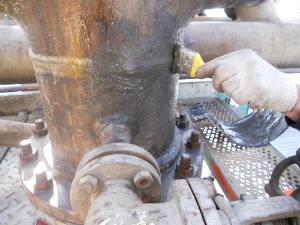 FIG. 4
FIG. 4
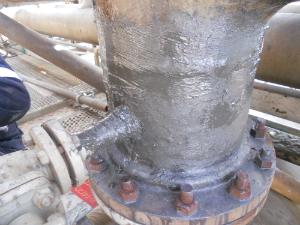 FIG. 5
FIG. 5
Next, a metal sleeve, previously prepared to measure, was covered with the heat-activated material and adjusted with screws (see Figure 6, 7, 8).
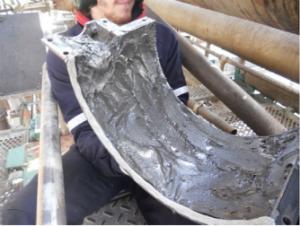
FIG. 6
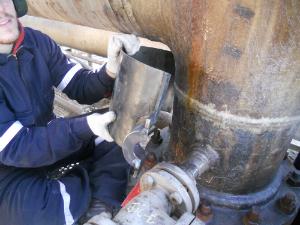
FIG. 7
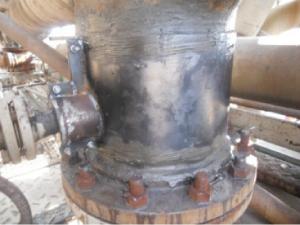
FIG. 8
Once the material was forged, the metal jacket was strongly adhered to the pipe section, which provided mechanical reinforcement, as well as greater protection against corrosion and the environment. The customer found that the entire process was carried out while the pipe section was in service.
These new, heat-activated materials can be used to coat, repair, adhere and protect a wide variety of metal substrates. Ease of use, fast curing and excellent adhesion with minimal surface preparation make these new heat-activated products preferred by customers for industrial repair situations, under similar conditions.
The products have the ability to perform repairs on pipes that are covered by insulating materials, where it is common to find advanced corrosion processes, known as Corrosion Under Insulation (CUI), as can be seen in Figures 9 and 10.
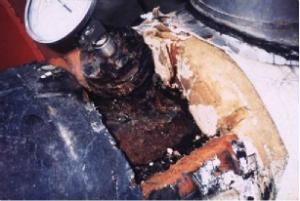 FIG. 9
FIG. 9
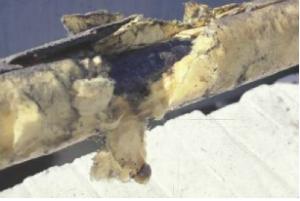 FIG. 10
FIG. 10
Recovering thickness in pipe walls and repairing active leaks represent some of the problems that can be solved with this new class of epoxy-based products. This solution allows those defective assets to be repaired correctly, without the need for unexpected stops and the use of welding that implies the risk of performing hot work. These types of easy-to-use products can be the answer to these needs.
* Pedro Sanchez is a technical service engineer at Belzona, Inc., 2000 NW 88 Court, Miami, FL, you can reach him at 305-594-4994.
























Leave your comment